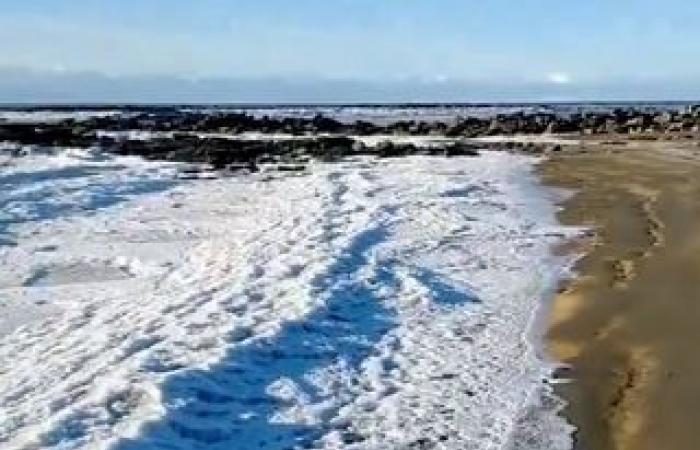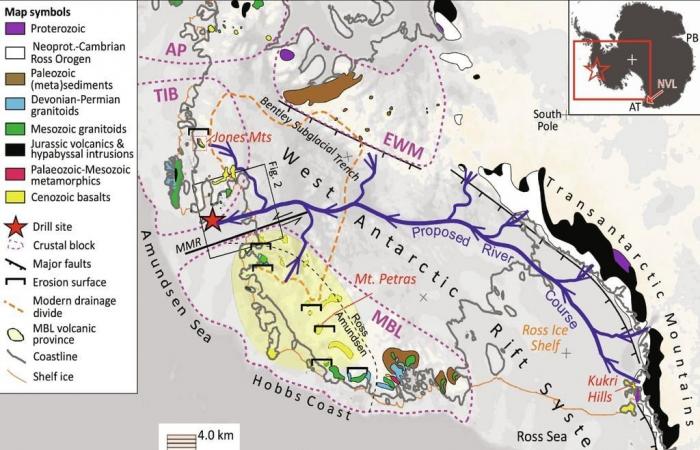A group of researchers found an ancient world lost beneath the deep ice of Antarctica. It is that A gigantic river meandered through there some 40 million years ago.Specifically, as he says, Live Sciencegeologists digging into the vast ice sheet of West Antarctica have discovered the remains of an ancient river system that at its peak spanned nearly 1,500 kilometers. The findings of this research were published on June 5 in the journal Science.
The Antarctic river existed about 40 million years ago and it was determined that its course reached 1,500 kilometers to the Amundsen Sea. In times even before the existence of this enormous river, several sectors of what is now western Antarctica were made up of temperate tropical forests.
One of the team members, Johann Klages, a sedimentologist at the Helmholtz Centre for Polar and Marine Research at the Alfred Wegener Institute in Germany, said: “If we think about possible severe climate change in the future, we have to learn from the periods in Earth’s history in which this has already occurred“The answers are in the planet’s own history.
Between 34 and 44 million years ago, in a geological epoch known as the middle-late Eocene, Earth’s atmosphere was dramatically transformed. At that time, carbon dioxide levels fell dramatically and the atmosphere lost much of its ability to sustain higher temperatures. Global cooling triggered the formation of glaciers on an ice-free Earth.
Know the past to predict the future
Scientists are now interested in understanding how this major climate event developed. in Antarctica, especially as carbon dioxide levels on Earth continue to rise due to man-made climate change.
The amount of carbon dioxide during the late Eocene was almost twice as high as today.. However, it could be similar to projected levels in about 150 to 200 years if greenhouse gas levels continue to rise.

Obtaining the material to investigate and reach these results is a scientific challenge. Today, most of West Antarctica is covered in ice.which makes it difficult to access sedimentary rocks, which are essential for studying primitive environments. That is why geologists often rely on the type of grains, minerals and fossils trapped in these sediments to determine the type of conditions that characterize an area.
The work began in 2017, when Klages and other scientists who made up the research team sailed from Chile aboard the ship Polarstern, the largest scientific research ship of all time. They had to cross the rugged Drake Passage and the western part of Antarctica. Equipped with advanced seabed drilling equipment, began collecting cores of soft sediments and hard rocks from the frozen seafloor.
Covered by miles of ice
Scientists were able to drill almost 30 metres into the seabed and recover sediments with layers from two different periods. By calculating the half-life of radioactive elements, such as the proportion of uranium and lead in the sediment, they discovered that the lower part of the sediment was formed during the middle Cretaceous period, about 85 million years ago. This sediment contained fossils, spores and pollens characteristic of a temperate rainforest, which existed at that time..
On the other hand, the upper part of the sediment contained mainly sand from the middle-late Eocene era, between 30 and 40 million years ago. After investigating the material in detail, they recognized a strongly stratified pattern in the Eocene sand layer that It resembled those from a river delta, very similar to those from rivers such as the Mississippi, the Rio de la Plata or the Amazon..
A lipid biomarker analysis was performed, in which they quantified the amount of lipids and sugars present in the sediment, and found a unique molecule usually found in cyanobacteria that live in fresh water.
The discovery confirmed their suspicions that an ancient river meandered across the continent millions of years ago. The researchers traced the Eocene grains to a distinct saline region in the Transantarctic Mountains, traversing an area spanning some 1,500 kilometers before draining into the present-day Amundsen Sea.
News reference:
Maximilian Zundel et al. A large-scale transcontinental river system crossed West Antarctica during the Eocene. Sci. Adv.10,eadn6056(2024).DOI:10.1126/sciadv.adn6056






